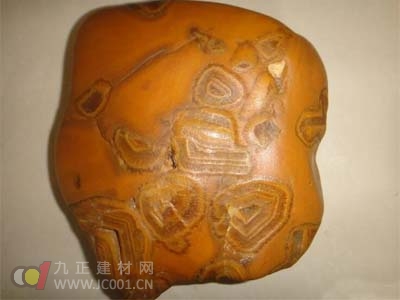How to Distinguish Real from Fake Yellow Wax Stone: Yellow wax stone, also known as Dragon King Jade, gets its name from the waxy texture and yellow color of the stone. Some believe it originates from a country known for wax, hence the name "stone." It is typically a silicified andesite or sandstone, mainly composed of quartz. The surface has an oily, waxy feel, and it is a low-temperature melt with a hardness between 6.5 and 7.5.
Due to its similar color, texture, and hardness to natural yellow jade (also called yellow enamel), many people—both consumers and jewelers—have mistakenly identified yellow wax stone as yellow jade when it first appeared on the market. Even some inspection departments have made errors in identifying it as genuine jade. However, there are clear differences that can help distinguish the two using non-destructive methods. These include differences in mineral particle size, density, refractive index, polished surface texture, and the distribution pattern of limonite under a high-powered magnifier.

Examining the graininess and polished surface: High-quality yellow wax stone is made of opal or chalcedony, with mineral particles generally smaller than 0.01 mm, which are invisible to the naked eye. In contrast, yellow jade (Astragalus) contains sodium-aluminum minerals, with larger particles visible to the eye. These particles may show optical effects like greenish spots or cloudiness, and their cleavage surfaces are often noticeable. This means that real yellow wax stone has very fine particles, making the polished surface smooth without visible micro-ripples or greenish spots.
Weight test: The density of yellow wax stone is around 2.60, while that of yellow jade is about 3.33. So, if you hold two stones of the same size, the yellow wax stone will feel significantly lighter than the genuine jade.
Refractive index measurement: The refractive index of yellow wax stone is approximately 1.54, whereas that of yellow jade is around 1.66. This difference results in a duller luster and less brilliance in yellow wax stone compared to genuine jade.
Limonite distribution under magnification: Under a high-powered magnifying glass, the yellow-brown colloidal limonite in yellow wax stone is evenly spread throughout the amorphous opal or cryptocrystalline chalcedony, without forming a network-like pattern. In contrast, the limonite in yellow jade tends to fill the spaces between fine-grained sodium-aluminum crystals, creating a distinct network structure.
Lamp bead
Using LED high lumen chip double gold line design, luminous stability,
Low light decline, prolong service life
The lamp body
Aluminum profile die casting aluminum production is not easy to rust, not easy to corrosion, beautiful appearance, fashion, atmosphere
LED Tunnel Light,tunnel light,tunnel lights,led tunnel lights
SHENGYA LIGHTING TECHNOLOGY CO., LTD. , https://www.syalighting.com